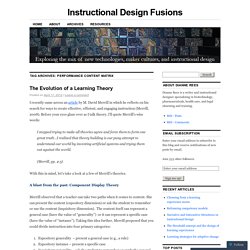

Five Questions to Ask Before Choosing an eLearning Format by Pamela S. Hogle: Page 2 : Learning Solutions Magazine. Strategies for learning and performance support 2: instruction. In last week’s post I looked at the simple strategy of exposition.

You will recall that this involved little more than the delivery of information from teacher or expert to the learner, perhaps with a little Q&A and discussion, but largely one-way. Assessment/Evaluation Topics. Instructional Strategies for Online Courses Effective online instruction depends on learning experiences appropriately designed and facilitated by knowledgeable educators.

Instructional Methods. Marzano Design Question 2: Helping Students Interact with New Knowledge - Marzano Center. Through critical input experiences, teachers let students know what information is important.

DQ 2 moves away from old teaching models and helps students take responsibility for their own learning. One of the more important design questions is Design Question 2, Helping Students Interact with New Knowledge. Research tells us that students must actively process new information in order to retain it, and in doing so interact with other students, the teacher, and the content. Design Question 2 guides teachers in designing instruction that allows students to construct knowledge through their interactions, an important step in moving up the ladder to self-directed learning. This moves education away from the old model where teachers processed the information, shared it through lecture, and had students repeat it back on a test.
Design Question 2 is the first of three design questions within the Lesson Segment, Addressing Content. . • Identifying Critical Information. Five E-Learning Design Strategies That Keep Learners Coming Back for More by Joe McCleskey. Along with the ARCS model, motivational psychologists have also identified two types of motivation, based on the motivating factor’s relationship to the learner.

These are intrinsic motivation, which originates from influences within an individual …, and extrinsic motivation, which comes from influences outside the learner …. Here’s one of the biggest problems we face as designers of e-Learning content: without the luxury of face-to-face interaction with our audience, how can we keep our audience motivated enough to not only complete the courses we create, but to actually enjoy learning the skills and knowledge we set before them? In this article, I offer a close look at some successful learner motivation methods that for many years have helped instructional designers enhance the learning experience. You can incorporate these into your e-Learning courses. Strategy 1: Learn the basics of motivation Attention This is essential. 10 Learning Design Strategies to Engage Learners Better. Trainers all over the world are facing many challenges to keep learners engaged and stay on track.

It is a well-known fact that today’s learners are unable to pay attention to the trainings and they are easily diverted from what they are doing, it’s because of technology, Internet, social networking sites (Facebook, Twitter, etc.), messengers, phones calls, text messages, mails, etc. and all these lead to short attention span and easy distraction. A study by Microsoft study focuses on the decreasing attention span of humans – from 12 seconds in 2000 to 8 seconds due to Smartphones. Socratic Questions In eLearning: What eLearning Professionals Should Know. Encourage your online learners to explore the subject matter and view problems with a fresh perspective.

In this article, I'll highlight the 6 types of Socratic questions and I’ll offer 5 tips on how to use Socratic Questions in eLearning. As Socrates once said: So, it makes perfect sense that this famous ancient Greek philosopher would introduce Socratic questioning to the world, a disciplined inquiry method that requires deep thinking, thought exploration, and questioning of our assumptions. Instead of just absorbing ideas that are being offered, learners must examine the logic and reason behind those ideas.
In eLearning environments, Socratic questioning can be a powerful tool, as it gives instructors the ability to assess learner knowledge. 6 Types of Socratic Questions Clarification. 5 Tips To Use Socratic Questions in eLearning Give learners time to reflect and explore the topic. Get 2 Free eBooks Get the eLearning Industry's Articles in your inbox. E-learning Design: Creating Excellent Learning Experiences [Infographic] The most important principle for designing lively e-learning is to see e-learning design not as information design but as designing an experience. – Cathy Moore Is your learning content text-heavy?
![E-learning Design: Creating Excellent Learning Experiences [Infographic]](http://cdn.pearltrees.com/s/pic/th/experiences-infographic-116623171)
How can you present this content in an effective and learner-friendly manner? Instructional Design Fusions. I recently came across an article by M.

David Merrill in which he reflects on his search for ways to create effective, efficient, and engaging instruction (Merrill, 2008). Before your eyes glaze over as I talk theory, I’ll quote Merrill’s wise words: I stopped trying to make all theories agree and force them to form one great truth…I realized that theory building is our puny attempt to understand our world by inventing artificial systems and trying them out against the world.
(Merrill, pp. 4-5) With this in mind, let’s take a look at a few of Merrill’s theories. A blast from the past: Component Display Theory Merrill observed that a teacher can take two paths when it comes to content. Expository generality – present a general case (e.g., a rule)Expository instance – present a specific caseInquisitory generality – ask the student to remember or apply the general caseInquisitory instance – ask the student to remember or apply the specific case PrerequisitesObjectivesHelpsMnemonicsFeedback. Instructional Design Fusions. What are best practices for designing group projects? What is true for individual assignments holds true for group assignments: it is important to clearly articulate your objectives, explicitly define the task, clarify your expectations, model high-quality work, and communicate performance criteria.

But group work has complexities above and beyond individual work. To ensure a positive outcome, try some of these effective practices (adapted from Johnson, Johnson & Smith, 1991) or come talk to us at the Eberly Center. Create interdependence While some instructors don’t mind if students divvy up tasks and work separately, others expect a higher degree of collaboration. If collaboration is your goal, structure the project so that students are dependent on one another. Instructional Strategies.